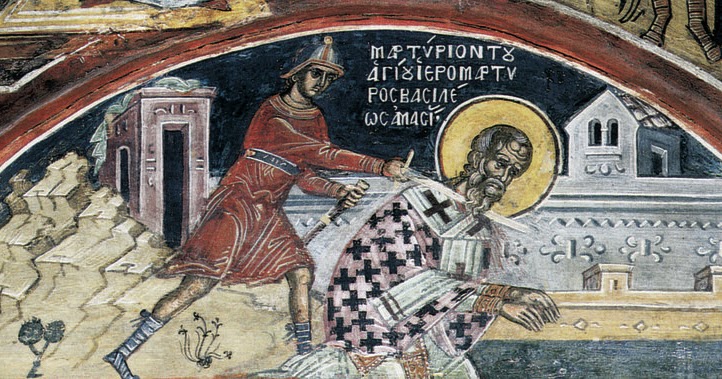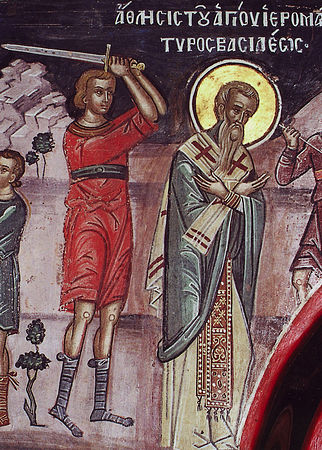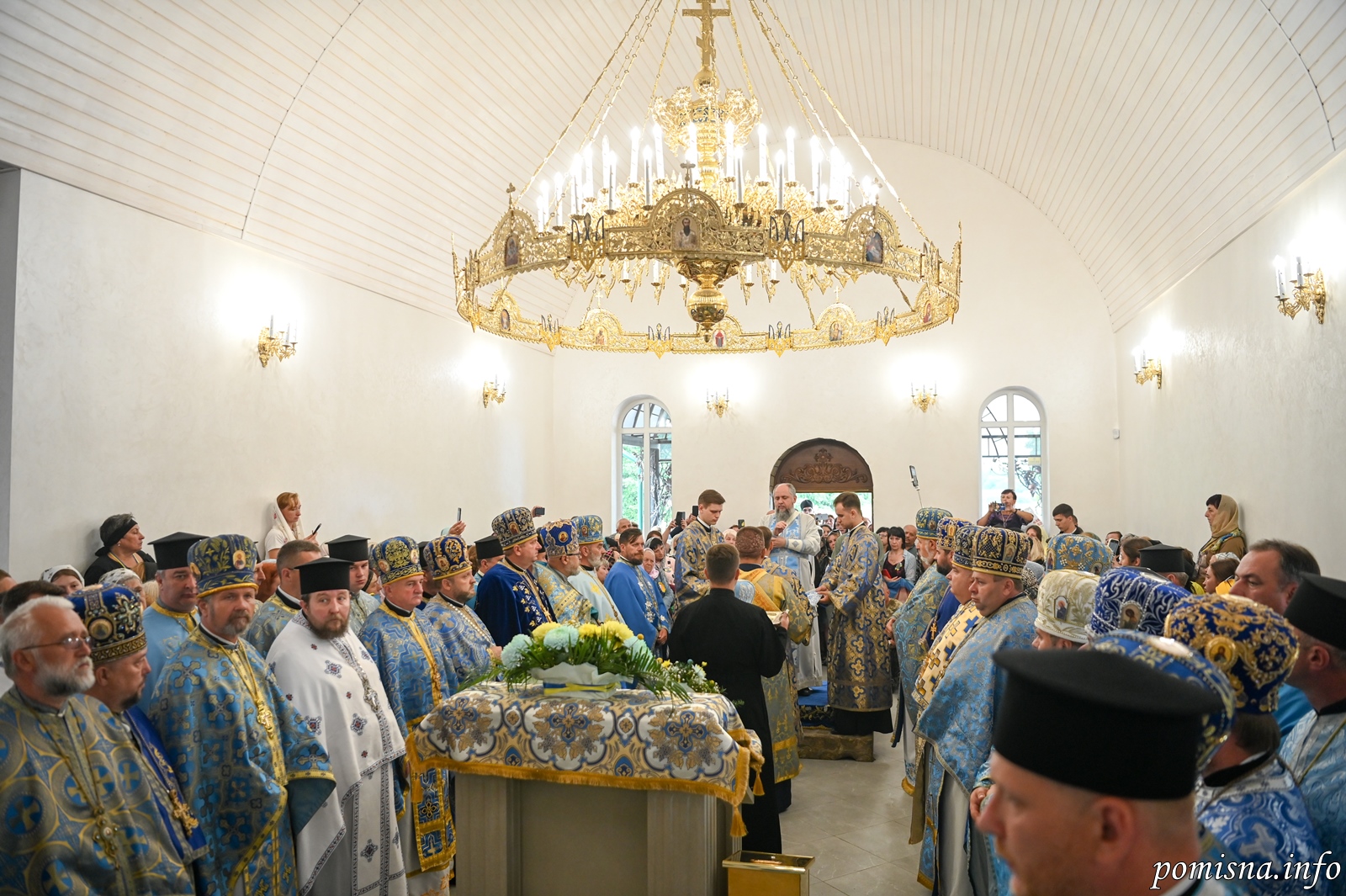Hieromartyr Basil, Bishop of Amasea (26 April)


Saint Basileus (Βασιλεύς, Βασίλειος) suffered during the reign of Licinius, the ruler of the Eastern part of the Roman Empire. He was elected to the See of Amaseia in the IV century, and participated in the Synods of Ankyra and Neocaesarea in 314 and 315. Saint Athanasios called him “the Great” because Saint Basileus defended the Faith against heresy. He may have influenced Saint Constantine’s decision to issue the Edict of Milan (313), granting religious toleration to Christians, Deceitfully, Licinius also signed the Edict, but he hated the Christians and continued to persecute them.
Bishop Basileus was distinguished for his life of faith and his tireless activities in the performance of his duties. He was always preaching, giving counsel, comforting, supporting, and strengthening the souls of the Christians against the world of idol-worshippers. For this reason, the pagan priests and rulers hated him. In 322, when Licinius launched his persecution against the Christians, Bishop Basileus opposed him.
He further provoked the wrath of Constantine’s co-Emperor Licinius by hiding the young virgin Glaphyra, the handmaiden of his wife Empress Constantia, the sister of Saint Constantine. The pious maiden, who came from a noble Italian family, angrily rejected the Emperor’s advances, asking Empress Constantia for her help. She dressed Glaphyra in men’s clothes and told her to leave Nikomedia in secret, giving her a large amount of gold, silver and precious stones. Those in the palace heard her tell Licinius that the girl had gone mad, and lay at death’s door.
After a long journey, Saint Glaphyra found herself in Amaseia, where she found shelter in the house of a pious Christian. There she was visited by Saint Basileus who advised her to lead a secluded life, so as not to bring any trouble upon the local Christians from the ruler of the city. At the time, Bishop Basileus was building a church, and the righteous Glaphyra donated all her money to him. She wrote to Constantia telling her where she was, and asking for more gold to be sent to complete the work. The Empress gladly fulfilled her request, but Glaphyra’s letter accidentally fell into the hands of Licinius. He ordered the ruler of Amaseia to send Saint Basileus and Saint Glaphyra to him at Nikomedia. However, Saint Glaphyra reposed before the order was received, and therefore, only Saint Basileus was sent to the Emperor. Two deacons, Parthenios and Theotimos accompanied him to Nikomedia.


At Nikomedia, Bishop Basileus was imprisoned, and the Deacons lodged with a Christian named Elpidophoros. On the eve of the trial Saint Basileus saw Elpidophoros and the Deacons, and told them how the Lord had appeared to him that night, informing him how he would be put to death. He asked the Deacons not to grieve for him and he told them to return to Amaseia. The holy hierarch predicted that Elpidophoros would receive a reward in Heaven for taking care of the Deacons.
At the trial, Licinius accused Saint Basileus of hiding Glaphyra, but promised him forgiveness and much honor if he would just sacrifice to their “gods.” Having achieved nothing, Licinius ordered the soldiers to beat the Saint, and then behead him. Thus, he received a crown of glory from Christ God (ca. 322).
After the execution, soldiers placed the Martyr’s body and head into a boat and, sailing far out to sea, they threw the relics into the water in different places, just as it was foretold to Saint Basileus in prison. That night an Angel appeared three times to Elpidophoros, saying that Saint Basileus was expecting his friends at Sinópē. While on his way to Sinópē the Angel appeared to him again with instructions as to where in the sea he should look for the Martyr’s body. At the request of Elpidophoros, fishermen pulled the Saint’s body out of the net. Miraculously, the head was reattached to the body. On the neck was there a scar made by the sword, and from the relics there came a wondrous fragrance. Some Christians took them to Amaseia and buried them in the church which the Saint had built.
The Greek Life of Saint Basileus was written by the priest John of Nikomedia, who visited the Martyr in prison and witnessed his execution. He also received information about Saint Basileus from Elpidophoros and the Deacons. The Life says that Saint Basileus was beheaded on March 28. His relics were found at sea after 25 days, i.e. April 21 or 22. They arrived in Amaseia and were buried five days later, on April 26.
Saint Basileus is also commemorated on April 30 (the transfer of his relics).
This Saint was Bishop of Amasia in Pontus, in the days of Licinius (reigned 308-324), fellow Emperor and brother-in-law of Saint Constantine the Great. Licinius’ wife Constantia, sister of Saint Constantine, had as handmaid a virgin named Glaphyra. When it became known that Licinius had conceived a sinful desire for her. Constantia secretly sent Glaphyra away to the East. Coming to Amasia, she took refuge with Saint Basileus. When Licinius learned of this, he furiously commanded that both be brought before him. When the soldiers came for them, however, Saint Glaphyra had already departed to the Lord; she is also commemorated this day. Saint Basileus was taken alone to Nicomedia, where he was beheaded. His body was cast into the sea, but through divine revelation was found again and brought back to Amasia.
Licinius, brother-in-law of Constantine, to whose sister he was married, pretended to be a Christian before the great emperor. When he received authority from the emperor to govern the entire East, he began, at first secretly and later openly, to persecute the Christians and to strengthen idolatry. His wife grieved much over this, but she was unable to dissuade her husband from this shamefulness. Giving himself over to idolatry, Licinius also gave himself up to all the passions without restraint but, most of all, to brutality toward women. Under the assault of these unclean passions, Licinius wanted to defile the virgin Glaphyra, who was in the service of the empress. Glaphyra complained to the empress, and the empress secretly sent her away from the imperial court of Nicomedia to the province of Pontus.
Glaphyra arrived at the town of Amasea and was cordially received by Bishop Basil and other Christians. Glaphyra was elated that God had saved her virginity, and she wrote to the empress concerning this. The empress also rejoiced and she forwarded money to the church in Amasea. However, a letter of Glaphyra’s, which was directed to the empress, fell into the hands of the emperor’s eunuch, who showed it to Licinius. The emperor, learning where Glaphyra was staying, immediately ordered that she and the bishop be brought back to Nicomedia. In the meantime Glaphyra died, and the soldiers brought Basil back to Nicomedia, alone and bound. Following tortures and imprisonment, this blessed man was beheaded and thrown into the sea, in the year 322 A.D.
Through a vision of an angel of God, his clergy found his body near the town of Sinope. They removed his body from the water with the aid of a fisherman’s net and translated it to Amasea, where they honorably buried it in the church which he, by his efforts, had built. The Emperor Constantine raised up an army against Licinius, defeated him, captured him, and exiled him to Gaul, where he ended his God-hating life.
Apolytikion of Hieromartyr Basil of Amaseia
Fourth Tone
As a sharer of the ways and a successor to the throne of the Apostles, O inspired of God, thou foundest discipline to be a means of ascent to divine vision. Wherefore, having rightly divided the word of truth, thou didst also contest for the Faith even unto blood, O Hieromartyr Basil. Intercede with Christ our God that our souls be saved.
Source: oca.org / goarch.org / westserbdio.org




